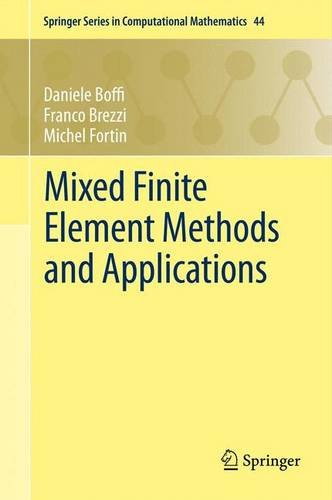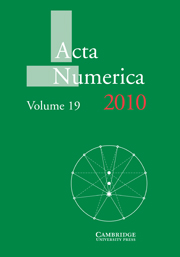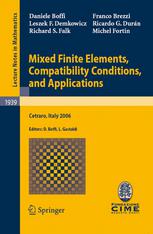Finite elements are the object of a wide and worldwide recognized research in Pavia. In particular mixed finite elements have been studied in Pavia since their earlier introduction. Interested people can look, for instance, at the following contributions



D. Boffi, F. Brezzi, M. Fortin. Mixed Finite Element Methods and Applications, Springer Series in Computational Mathematics, Vol. 44, 2013
D. Boffi. Finite element approximation of eigenvalue problems, Acta Numerica, 19 (2010) 1-120
D. Boffi, F. Brezzi, L.F. Demkowicz, R.G. Durán, R.S. Falk, M.Fortin. Mixed Finite Elements, Compatibility Conditions, and Applications, Springer Lecture Notes in Matematics, Vol. 1939, 2008
Interested students are given several opportunities for a fuitful Ph.D. program. A common denominator for the research topics is that the numerical approach is based on a rigorous mathematical analysis of the approximation schemes (well-posedness, stability, convergence, etc.) and on the numerical validation of the theoretical results.
Contact researcher: Daniele Boffi
Eigenvalue problems arising from partial differential equations model several interesting phenomena. Surprisingly enough, eigenvalue problem in mixed form require much deeper mathematical analysis than standard one in order to show the convergence of their finite element approximation. The abstract theory in this case is well understood and relies on suitable conditions ensuring a so called discrete compactness property for the involved finite element spaces.
The Immersed Boundary Method (IBM) is a method that has been introduced by Peskin in the 70's for the modeling and the approximation of fluid-structure interactions arising from biological models. The peculiarity of the IBM consists in the fact that the presence of the solid, immersed in the fluid, is modeled via an additional source term to the Navier-Stokes equations describing the fluid evolution. This allows for a fluid resolution on a fixed mesh; moreover, another important feature is that the source term referring to the immersed body is defined by making use of a description of the solid in its reference configuration. The original version of the IBM makes use of finite differences for the resolution of the Navier-Stokes equations. In Pavia we developed a finite element version of the IBM which present several interesting properties. The research in this field is still very active and offers opportunities, both from the theoretical and practical point of view.
The analysis of adaptive finite element schemes has been the object of increasingly active research during the last decade. In particular, the convergence of the adaptive scheme and the optimal rate of convergence has been proved for several problems of interest. More recently, adaptive schemes for eigenvalue problems have been considered. In this case, it has been observed that it is more natural to consider the approximation of cluster of eigenvalues rather than of single eigenvalues. This is in particular necessary when multiple (or very close to each other) eigenvalues are present. Rigorous proof of the optimal rate of convergence for the adaptive scheme in case of mixed probems is a tough problem and has been solved only for very particular situations.
It is well-known that finite element spaces on distorted meshes can degenerate for what approximation properties are concerned. Finite element based on tensor product structure, in particular, have to be considered with particular care. This is the case, for instance, for the widely used mixed finite element (Raviart-Thomas, Nédélec, Brezzi-Douglas-Marini, ecc.). Sufficient and necessary conditions for optimal approximation have been proved in particular situations. Sufficient conditions have been provided in a general setting (k-forms in n-dimensions in the spirit of de Rham complex).
The finite element approximation of problems related to Maxwell's system requires special finite element spaces originally introduced by Nédélec. For these spaces several properties are known: discrete compactness property, (lack of) approximation properties on distorted meshes, etc.. The right setting for this study is the so called Finite element exterior calculus where tools of differential topoloigy related to de Rham complex are used for the contruction of finite element spaces.